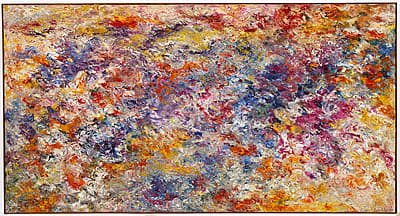
Jon
SCHUELER
United States of America
1916
–
1992
The first day
1956
oil on canvas
121.9 (h)
x 228.6 (w)
cm
Gift of Andrew Salvesen 2010
National Gallery of Australia, Canberra
NGA 2010.1170
- Andrew Salvesen, the artist’s brother-in-law;
- by whom given, through the Liverpool Street Gallery, to the National Gallery of Australia, Canberra, December 2010
- Abstract Expressionism: the National Gallery of Australia celebrates the centenaries of Jackson Pollock and Morris Louis
- 14 Jul 2012 – 24 Feb 2013
- Christine Dixon, ‘Jon Schueler: The first day’, artonviewno. 66, Winter 2011, p. 31, illus col.
Jon Schueler attempts perhaps the most ambitious subject possible in his painting The first day 1956. The title refers to the creation of the Earth as narrated in the opening words of the Bible (King James Version), Genesis 1:
In the beginning God created the heaven and the earth … And God saw the light, that it was good: and God divided the light from the darkness. And God called the light Day, and the darkness he called Night. And the evening and the morning were the first day.
Conventional Romantic depictions of the subject, such as that of John Martin, use deep black and blazing white to show the division of light from darkness. Instead, Schueler renders the dazzling beauty of light as it is divided into colour. Theories about perception, the chemistry of paint and the meaning of colour become important in his realisation of such a difficult subject.
The immaterial becomes material. Blues and yellows are contrasted with hues of orange, red and purple, all made with myriad small strokes from a palette knife. The technique imbues the paint with a rhythmic, nervous quality so that the colours flicker before our eyes. The first day is rich in impasto and the large canvas imparts a joyous effect, which changes according to the distance between the painting and the viewer.
Schueler was the first artist to have a solo show at the Leo Castelli Gallery, in 1957, the year it opened. The exhibition, including The first day, appeared to announce a new star in the firmament of the New York School. But, perhaps due to the maturing of the second generation of Abstract Expressionists—Helen Frankenthaler, Barnett Newman, Morris Louis—or to the complications of his turbulent private life, Schueler’s increasingly individual trajectory of sky subjects and Turneresque Romanticism placed him outside the circle. The first day anticipates the artist’s development into a modern landscape painter of transcendent scenes.
Christine Dixon
Literature
- Christine Dixon, ‘Jon Schueler: The first day’, artonviewno. 66, Winter 2011, p. 31, illus col.
Discussion of the work
Jon Schueler attempts perhaps the most ambitious subject possible in his painting The first day 1956. The title refers to the creation of the Earth as narrated in the opening words of the Bible (King James Version), Genesis 1:
In the beginning God created the heaven and the earth … And God saw the light, that it was good: and God divided the light from the darkness. And God called the light Day, and the darkness he called Night. And the evening and the morning were the first day.
Conventional Romantic depictions of the subject, such as that of John Martin, use deep black and blazing white to show the division of light from darkness. Instead, Schueler renders the dazzling beauty of light as it is divided into colour. Theories about perception, the chemistry of paint and the meaning of colour become important in his realisation of such a difficult subject.
The immaterial becomes material. Blues and yellows are contrasted with hues of orange, red and purple, all made with myriad small strokes from a palette knife. The technique imbues the paint with a rhythmic, nervous quality so that the colours flicker before our eyes. The first day is rich in impasto and the large canvas imparts a joyous effect, which changes according to the distance between the painting and the viewer.
Schueler was the first artist to have a solo show at the Leo Castelli Gallery, in 1957, the year it opened. The exhibition, including The first day, appeared to announce a new star in the firmament of the New York School. But, perhaps due to the maturing of the second generation of Abstract Expressionists—Helen Frankenthaler, Barnett Newman, Morris Louis—or to the complications of his turbulent private life, Schueler’s increasingly individual trajectory of sky subjects and Turneresque Romanticism placed him outside the circle. The first day anticipates the artist’s development into a modern landscape painter of transcendent scenes.
Christine Dixon
